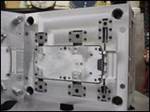Scanner Touch Tool Determines Parting Lines on Free Form Parts
A process has been developed that uses a “touch tool” combined with a NextEngine 3-D scanner (Santa Monica, CA) to determine a mold parting line.
A process has been developed that uses a “touch tool” combined with a NextEngine 3-D scanner (Santa Monica, CA) to determine a mold parting line. The process was created in response to the challenge of efficiently identifying and transposing into a digital format the parting line of an organically shaped mold object.
The process was designed by Reynald Chaput, owner of Ideas in 3D (Torrance, CA)—a scanning service provider—and is a highly accurate system that captures edge data and merges it with the “clouds of point” that are created when surfaces are digitized. Chaput points out that the fundamental problem with scanning is that a great deal of data ends up in a point cloud. “None of the point data can ever land on the edges,” Chaput says.
A Dual System
Ten years ago, Chaput decided those two systems were necessary to determine parting lines—one for surfaces and one for edges. He couldn’t find a scanner designed for edges, so he designed and built his own. The READ (Reverse Engineering and Digitizing) system has a manual probe with a laser that constantly recalibrates the probe’s exact location. “This system does not generate point clouds, it just does edges,” Chaput notes.
Establishing the parting line and shut-off surfaces are critical for mold work. “The job will not come out properly if these two steps are not done correctly in the beginning,” Chaput notes. “The parting line is created on the actual part with a ‘touch tool’ and establishes the parameters of the mold’s core and cavity parting planes surfaces and how they will mate. The parting line also determines the quality of the molded piece in terms of flash.”
The new final elements to this system are the NextEngine (Santa Monica, CA) desktop scanner used in conjunction with NextEngine’s RapidWorks—a version of the Powerful Free Form software, RapidForm. “These are the only products that I have seen that can manipulate a cloud of points and are able to create a roller coaster parting line in the form of lines and splines dynamically onto the point cloud,” Chaput explains. “With this system, the user can easily create machinable CAD geometry from the .igs parting line and create NURBS parting planes in any CAD software. In addition to merging edge and surface files, this software can convert digitized points into triangles such as .stl (stereolithography tessellation language) systems. Then, .stl files or triangle files can be cut with any CNC machine—provided that one has the proper machining software to create the programs.”
Chaput’s personal preference for creating the programs from .stl files is PowerMill from software manufacturer Delcam International (Windsor, ON). “This product cannot gouge because compared to machining hundreds of surfaces, the user is only machining one triangle mesh that cannot be pierced or violated,” Chaput explains. “It also is very well suited for the CAM programming of the laser scanning process.”
Lastly, Chaput adds that this new technology allows his company to accept complex, free form work with no worries. “On molds this complex, it’s nice to be able to accept this complex work and go to church on Sunday instead of the welder.”
Related Content
Leading Mold Manufacturers Share Best Practices for Improving Efficiency
Precise Tooling Solutions, X-Cell Tool and Mold, M&M Tool and Mold, Ameritech Die & Mold, and Cavalier Tool & Manufacturing, sit down for a fast-paced Q&A focused on strategies for improving efficiencies across their operations.
Read MoreHow to Select a Mold Temperature Controller
White paper shares how cooling channel analysis, which collects maximum pressure drop, total flow rate and heat dissipation, eases the performance evaluation of mold temperature controllers.
Read MoreHow to Improve Your Current Efficiency Rate
An alternative approach to taking on more EDM-intensive work when technology and personnel investment is not an option.
Read MoreMoldMaking Technology's Most-Viewed Content 2022: Products
MMT shares the five top-viewed technologies, equipment and services of 2022 in each Engineer, Build, Maintain and Manage tenet based on Google Analytics.
Read MoreRead Next
New Design Strategy for Generating Hybrid Aluminum Tooling
Design, machining and analysis software aids in aluminum mold manufacture.
Read MoreAre You a Moldmaker Considering 3D Printing? Consider the 3D Printing Workshop at NPE2024
Presentations will cover 3D printing for mold tooling, material innovation, product development, bridge production and full-scale, high-volume additive manufacturing.
Read MoreHow to Use Continuing Education to Remain Competitive in Moldmaking
Continued training helps moldmakers make tooling decisions and properly use the latest cutting tool to efficiently machine high-quality molds.
Read More.jpg;maxWidth=970;quality=90)












.jpg;maxWidth=300;quality=90)
_300x250 4.png;maxWidth=300;quality=90)











